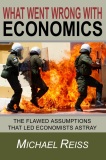 Back in March I wrote a blog entry on the value of money in which I suggested a mechanism whereby it may be possible to write a computer simulation of an economy in which the value of money could be discovered. Well I finally have some results...
Back in March I wrote a blog entry on the value of money in which I suggested a mechanism whereby it may be possible to write a computer simulation of an economy in which the value of money could be discovered. Well I finally have some results...But first of all I should be clear about exactly what problem I am trying to solve, so I shall present the following conundrum. Imagine a very simple society in which there is only one commodity: sandwiches. Everyone in the land grows the ingredients for their sandwiches in their gardens. Often they will exchange sandwiches with their neighbors just for variety. There is no money in this society only barter. But then one day the king of the land says "I've just invented something I'm going to call money. It consists of metal coins called shekels. I will give everyone in the land 1000 shekels and from now on bartering is banned. All exchanges must be via the medium of exchanging shekels. What's more, nobody is allowed to eat their own sandwiches." The question now is: how many shekels will a sandwich cost? It may well be that on day one, people will not have a clue and all sorts of silly prices may get paid... but presumably over time the price will gravitate towards a certain value. What will that value be? I suspect that no economist (to date) has ever answered this question.
I actually thought of this problem around ten years ago but only recently did I work out that it was soluble via a computer simulation and now I've finally written it and tweaked the many parameters such that I get a stable price.
What I'd like to do now is publish this work, but I am not in a position to do this on my own. My academic credentials (in the field of economics) are simply not good enough, and I am not currently working in an academic institution. So I am seeking a partner.
I shall publish more information about my simulations at a later date. I may even make the source code public domain. By the way, there is no reason the simulation could not be expanded to incorporate multiple commodities, lending, banking and many other features to make it more accurately reflect the real world.




Fascinating, I most recent post is about graph theory and cash flow in finite networks with a fixed supply of currency. I also started to look at loan transactions in a network in my graph theory notes, but haven't finished them yet. Cheers.
ReplyDeleteA simple engineer reading regularly your blog and willing to help if possible. PS : there is a little glitch in your former article you link to ;please replacer in the PS "W_gt[G+X,t]-W_gt[G+X,t]" with "W_gt[G+X,t]-W_gt[G,t]"
ReplyDeleteWell done spotting my error (now fixed).. I never knew anyone was paying attention :-)
ReplyDeleteAnd thanks very much for the offer of help - although what I really need is an economist working in a similar field in an academic institution.